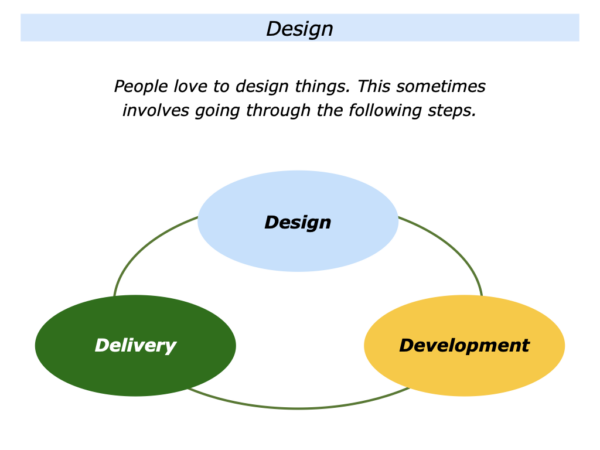
Human beings are natural designers. They love to make things work, find solutions to challenges or create their version of paradise. Some love to design experiences that enrich people’s lives or take them into another dimension.
Imagine that you want to design something. One approach involves going through the following steps.
Design
You can decide on something you want to design. You may want to write an article, do a mentoring session, run a workshop, revitalise a room, lead a team, build a culture or do another activity. You can clarify the real results you want to achieve with the piece of work.
Development
You can develop the strategies you can follow to deliver success. You can do your research and clarify: a) the strategies that are most likely to work; b) the challenges and solutions. You can then rehearse and develop these strategies until you feel ready to do the piece of work.
Delivery
You can go into your version of the arena. You can be fully present, follow your chosen strategies and keep reading reality. You can build on what is working and find solutions to challenges. You can do your best to achieve the desired results and deliver the piece of work.
Christopher Alexander, the architect, said that all human beings have a strong drive to create. Writing in The Timeless Way of Building, he described this in the following way.
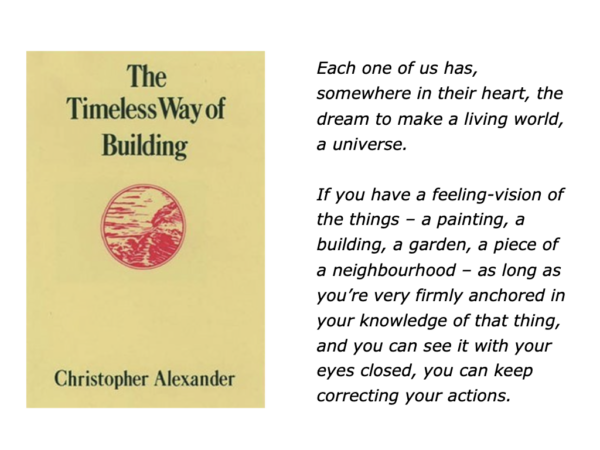
There is one timeless way of building. It is a thousand years old, and the same today as it has ever been.
The great traditional buildings of the past, the villages and tents and temples in which man feels at home, have always been made by people who were very close to the centre of this way.
Architects nurse this desire at the centre of their lives, says Christopher. One day, somewhere, somehow, they want to create a building that is wonderful, a place where people can walk and dream for centuries.
Every person has some version of this dream, says Christopher. Some wish to create a house, a garden or a fountain. Others wish to create a relationship, a painting or a book. The following sections explore some of the different ways to design, develop and deliver great work.
The Simple, Satisfying
And Successful Approach
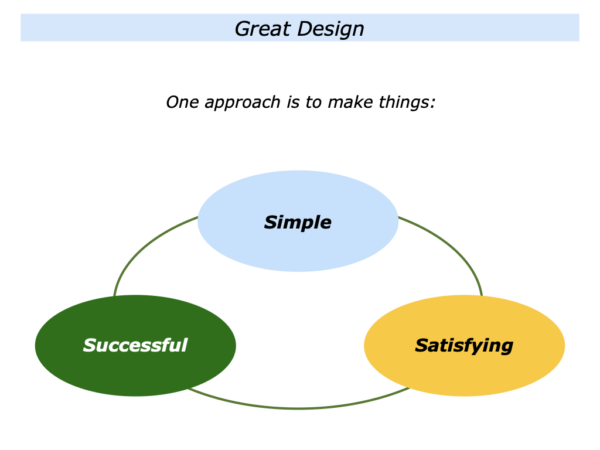
Some designers make things that are simple – in a profound way – satisfying and successful. They make beautiful things that work.
They follow these principles whether they are providing a service, designing a product, building an organisational culture or doing another activity. Let’s explore these themes.
Making It Simple
Simplicity is genius, we are told. Art Fry’s invention of Post-it Notes demonstrated simplicity in action. So did the Sony Walkman and the Apple Macintosh. Here are some views on simplicity.
Simplicity is the ultimate sophistication. Leonardo da Vinci
Everything should be as simple as possible – but no simpler.
Albert Einstein
Perfection is achieved not when there is nothing more to add, but when there is nothing more to take away. Antoine de Saint Exupéry
Making It Satisfying
Superb design is satisfying on a number of levels. Physically it looks and feels good. Practically it works and is user-friendly. There is an old Shaker dictum that says:
Don’t make something unless it is both necessary and useful;
but if it is both necessary and useful,
don’t hesitate to make it beautiful.
Frank Lloyd Wright’s famous house Fallingwater shows how something can be simple, satisfying and successful.

Making It Successful
Great design works. It is sometimes simple, beautiful and effective. It does the job. Here are some quotes on this theme.
Design is not just what it looks like and feels like. Design is how it works. Steve Jobs.
Good design is probably 98% common sense. Above all, an object must function well and efficiently – and getting that part right requires a good deal of time and attention. Terence Conran.
Pioneers often build prototypes that show a better way. They do not spend their time trying to change the old way of doing things. They may aim to build sustainable systems that deliver ongoing success.
Different people do this in different ways. Let’s look at how some educators are helping their students to develop these skills.
The Feel, Imagine,
Do And Share Approach
Kiran Bir Sethi has done superb work that helps people and the planet. She founded the Riverside School in Ahmedabad and the global movement called Design For Change.
This encourages thousands of children to implement their ideas for building a better world. Here is an excerpt from its website.
Children and adults can shape their futures by moving from saying “Can I?” to “I Can.” They can find something that bothers them, do something about it and make change happen. They can do this by following the design process of Feel, Imagine, Do and Share.
Children are dreaming up and leading brilliant ideas all over the world. They are implementing ideas from challenging age-old superstitions in rural communities, to earning their own money to financing school computers to solving the problem of heavy school bags.
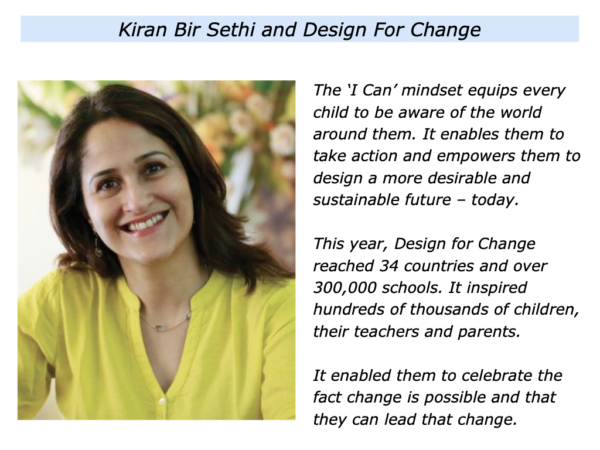
Children focus on challenges on their own doorstep. They may aim to clean local rivers, convert garbage dumps into playgrounds, ensure school friends can get home safely, care for the elderly or do other activities.
Kiran has a background in design. She and her colleagues therefore invite children to tackle challenges by going through the design process of Feel, Imagine, Do and Share.
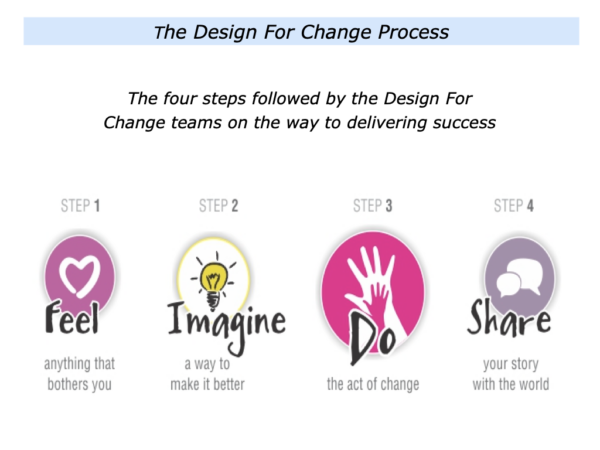
Feel
Focus on something you feel strongly about. This could be something that bothers you or something you want to improve. Start to explore your desired picture of success.
Imagine
Imagine a way to make it better. Explore what good looks like and search the world for examples of best practice. Focus on what you can control and clarify your picture of success.
Do
Do the necessary work. This can be an eye-opener for some young people, because it calls for sweat and overcoming setbacks on the road to achieving success. One student described this in the following way.
“This part taught us to develop persistence. Our generation is used to having a short attention span and, if we get bored, moving on to the next idea. But we realised that you have to be persistent to make change happen. That taught us a lot.”
Share
Share your story with the world. The students make videos of their work and also take part in the annual Design For Change School Challenge. These stories provide inspiration for others who want to achieve their pictures of success.
Kiran explains how this approach is helping young people to develop the skills necessary for shaping the future. She describes this in the following way.
The Feel, Imagine, Do, Share framework helps to develop the much required 21st Century Skills in children. It builds their social and emotional competencies and promotes employability skills.
The power of Design Thinking allows both children and adults to transform the world into how they envision it – the power to create a more compassionate, empathetic world.
The Creative Problem
Solving Approach
People love to design, develop and deliver solutions to challenges. There are many models for creative problem solving.
This section provides an introduction to Three C approach. It describes how people can find solutions by focusing on Clarity, Creativity and Concrete Results.
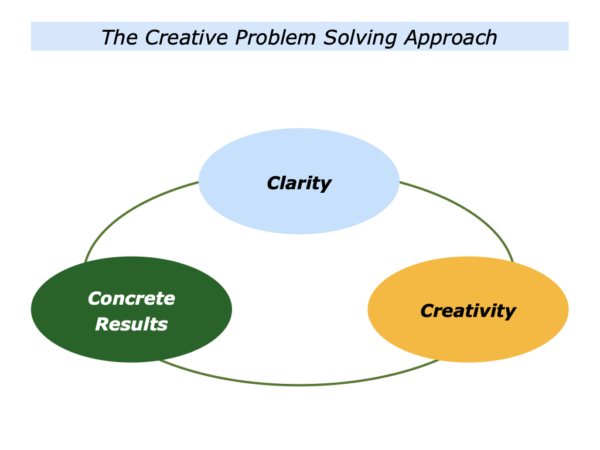
This model can be used in many situations. It can be used in mentoring sessions. It can also be used for helping teams, organisations and communities to find solutions.
There are virtually always solutions to challenges. Some solutions may work superbly; some may cost money; some may cost very little. Some may please everybody; some may please fewer people. Some may simply be a case of doing the best you can in the circumstances.
Imagine that you are helping a group that wants to find solutions to a particular challenge. It can be useful to guide people through the following stages.
These are similar to when mentoring an individual. When working with a group, however, you will need more time to give people chance to share their views and then settle on their chosen way forwards.
Clarity
Clarity is crucial. It is vital to clarify the real What – the real results to achieve – before moving on to the How. Bearing this in mind, it can be useful to invite people to work through the following questions.
What is the challenge we want to tackle? For example: ‘How to …?’ What are the things we can control in the situation? How can we build on what we can control and manage what we can’t?
What are the real results we want to achieve? What is the picture success? What will be the benefits of achieving the goals? What will be happening that will show us we have achieved the picture of success?
It important to frame the challenge in a positive way. For example, to say:
“How can we improve people’s wellbeing?” rather than: “How can we help people to feel less stressed?”
“How can we, as far as possible, get win-wins?” rather than: “How can we stop behaving in ways that mean many people lose?”
“How can we use our strengths and work together towards achieving a common goal?” rather than: “How can we stop having conflicts?”
People may also be more motivated to achieve a goal if they see the benefits. It can therefore be good to describe the benefits for all the potential stakeholders.
People may want to achieve many goals. If so, it can be useful to list these in order of priority. People can then translate these into a clear picture of success. For example:
The Picture Of Success
The challenge we want to tackle is: How to …
The real results we want to
achieve – in order of priority – are:
* To …
* To …
* To …
The benefits of achieving
the picture of success will be:
* To …
* To …
* To …
Creativity
Imagine that you have helped a group to establish clarity. You can then invite them to work through the following questions.
What are the possible options for going forwards? What are the pluses and minuses of each option? What is the attractiveness of each option?
Are there any other potential creative solutions? What are the key strategies we can follow to give ourselves the greatest chance of success?
It can be useful to invite people to start by brainstorming all the potential options, even those that they may initially dismiss. They can then see that they have many choices in the situation.
Looking at each option in turn, people can list: a) the pluses and minuses of each option; b) the attractiveness of each option on a scale 0/10. People can then produce something like the following chart.
Option A is: To …
The pluses are …
The potential minuses are …
The attractiveness rating is … / 10
Option B is: To …
The pluses are …
The potential minuses are …
The attractiveness rating is … / 10
Option C is: To …
The pluses are …
The potential minuses are …
The attractiveness rating is … / 10
Imagine that people have described what they see as the options going forwards. If appropriate, invite people to take a short break and return refreshed.
You can then take more of a steer and, if okay with the group, also offer some other options for achieving the aims. One approach is to reset the session by saying something along the following line.
As far as I understand, the
goals we want to achieve are:
* To …
* To …
* To …
Bearing these in mind, let’s consider all the possible ways forward. We will then settle on our strategy for achieving the picture of success.
Looking ahead, are there any other potential options? Is it possible, for example, to combine the best parts of the most attractive options? If so, what might be a potential way forwards?
Let’s learn from your positive history. Looking back, when have you tackled a similar challenge successfully? What did you do right then? What were the principles you followed? How could you follow these principles – plus add other skills – to tackle this challenge successfully?
Let’s learn from other people’s positive history. Looking back, have another other people or groups tackled a similar challenge successfully? What did they do right then? How can we follow these principles in our own way to tackle the challenge successfully?
If appropriate, let’s consider how to find solutions to any potential conflicts. What does each person or each party want? How can we build on what people have in common? How can we, as far as possible, find win-win solutions?
Let’s try to look at the situation in a dispassionate way. Imagine that we were outside consultants who had been invited to provide impartial advice.
Looking at the situation from above, what would we advise this group to do? Which option – or combination of options – would we advise people to pursue?
Is it okay for me to share some more ideas? Looking at the results you want to achieve, here are some options it may be worth considering.
Option D could be to…
Option E could be to…
Looking at all the options, which are the ones that make sense? Which of these would we like to explore further?
Looking at this chosen option, how these might this look in practice. What would be the pluses and minuses of pursuing this option? How could we build on the pluses and minimise the minuses?
Let’s return to the real results we want to achieve? What are the key strategies we can follow to give ourselves the greatest chance of success?
Concrete Results
Imagine you have helped the group to work through the previous stages. It is then time to settle on the way forwards. If appropriate, you can guide them through exploring the following themes.
Let’s return to the picture of success. What is the option – or the combination of options – we want to pursue? How can we translate this into a clear action plan?
What are the clear working contracts that we need to make about who does what and when? Who would like to be the Mission Holder who takes responsibility for guiding the plan?
Who else would like to contribute towards achieving the goals? What would you each like to do and by when? What are the other practical tasks that need to be done? How can we make sure these get completed?
How will each of us proactively keep people informed about our progress towards achieving the goals? What support do people need? How can we encourage ourselves on the journey? What can we do to get some quick successes?
Let’s do a success rating. Bearing in mind what we can control, how would we each rate the chances of us reaching the goals. Do this on a scale 0-10. What can we do to increase the chances of success?
People are ingenious and are capable of finding solutions to challenges. When working with groups of people, however, there are several key issues to focus on. These are:
To create a positive atmosphere in which people feel at ease and take time to clarify the real results to achieve – the picture of success;
To use the Three C Model for helping people to clarify their options and their chosen strategy for achieving the picture of success;
To encourage people to commit themselves to their chosen strategy, make clear contracts and do their best to achieve the picture of success.
Good decision makers recognise there are pluses and minuses to each option. Whatever their chosen way forwards, they build on the pluses, minimise the minuses and do their best to achieve success.
Let’s return to your life and work. Looking ahead, can you think of something you would like to design? If so, it can be useful to work through the following themes.
Design
What would you like to design? What are the real results you want to achieve by doing this project? What is the picture of success? What will be the benefits of achieving the goals – both for yourself and other people?
Development
How can you gather information about this potential project? How can you study what has worked in this past? How can you explore what could work in the future? How can you develop the prototype? How can you test it to see if it will deliver the required results?
Delivery
How can you set things up to succeed when delivering the design? How can you do superb work? How can you keep doing reality checks about: a) what is working) what can be improved? How can you do your best to deliver success?
If you wish, try tackling the exercise on this theme. This invites you to complete the following sentences.
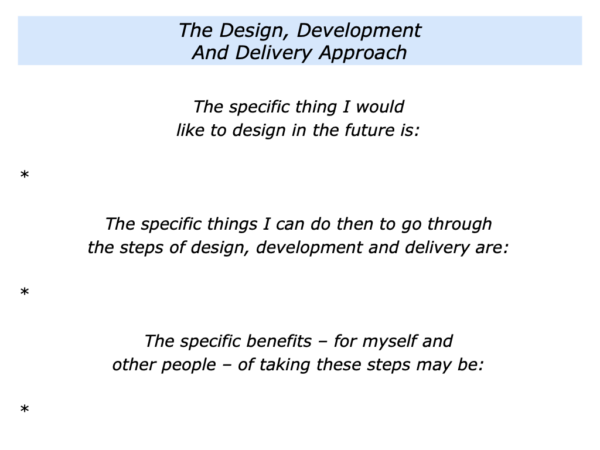






Leave a Reply